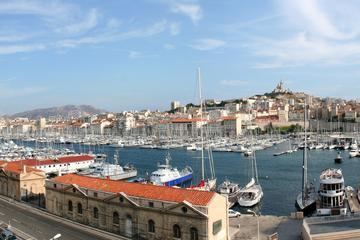Country France Opened 6th century BC Owned by State | Operated by City Type of harbor Natural | |
 | ||
Similar Notre‑Dame de la Garde, Fort Saint‑Jean, Museum of European and Medit, Palais Longchamp, Marseille Cathedral | ||
The Old Port of Marseille (French : Vieux-Port) is located at the end of the Canebière. It has been the natural harbour of Marseille since antiquity and is now the main popular place in Marseille, mainly pedestrian since 2013.
Contents
- Map of Old Port of Marseille France
- Marseille le vieux port old port and notre dame de la garde
- History
- The Old Port in popular culture
- Points of interest around the Old Port
- References
Map of Old Port of Marseille, France
Marseille le vieux port old port and notre dame de la garde
History
In 600, Greek settlers from Phocaea landed in the Lacydon, a rocky Mediterranean cove, now the site of the Old Port of Marseille. They set up a trading post or emporion in the hills on the northern shore. Until the nineteenth century the Old Port remained the centre of maritime activity in Marseille. In the Middle Ages the land at the far end of the port was used to cultivate hemp for the local manufacture of rope for mariners, which is the origin of the name of the main thoroughfare of Marseille, the Canebière.
The great St. Victor's Abbey was gradually built between the third and ninth centuries on the hills to the south of the Old Port, on the site of an Hellenic burial ground.
Between the fifteenth and seventeenth centuries, quays were constructed under Louis XII and Louis XIII and an important shipyard for galleons put in place. Following a revolt against their governor by the citizens of Marseille, Louis XIV ordered the erection of the forts of St Jean and St Nicolas at the entrance to the harbour and established an arsenal and fleet in the Old Port itself. The notorious "arsenal des galères" was situated on the left side of the Old Port between the Cours Jean-Balard and the Cours Estienne-d'Orves: those condemned to be galley slaves in the royal war fleet were branded with the letters GAL.
According to John Murray, in 1854 the Old Port had a capacity of between 1,000 and 1,200 ships. Roughly 18,000 merchant ships passed through the port each year, carrying about 20 million barrels worth of freight; this represented a quarter of the trade in Liverpool at the time. The 6 metre depth of the harbour, however, proved problematic for steamships later in the century; much deeper docks had to be constructed at La Joliette. In World War II the Old Port was left in complete ruins. According to eye-witness accounts, in January 1943, the Nazis, aided by the French police, dynamited much of the historic old town and demolished the gigantic aerial ferry or "transbordeur", an engineering tour de force that had become a major landmark of Marseille, comparable to the Eiffel tower in Paris. This became known as the "Battle of Marseille". In 1948 Fernand Pouillon was put in charge of the reconstruction of the devastated old quarter.
When, beginning in the 1840s, new harbour moles, quays and the Docks were built along the coast of the La Joliette quarter to the north-west, many port activities were moved out of the Old Port. Over time, new harbour installations were built further north-west, resulting in what is today the Grand Port Maritime de Marseille: continuous harbour installations as far as L'Estaque and the southern entrance to the Rove Tunnel, and "satellite" extensions around Fos-sur-Mer and along the shore of the Étang de Berre. The Old Port is used today as a marina, as a terminal for local boat trips, and hosts a local fish market. In 2013, for the European Capital of Culture, the Old Port was largely pedestrianized. It has been renovated as a large public square following an international competition won by Michel Desvigne Paysagistes, with Foster and Partners. The project is also to have a second phase with parks to be built around the port in 2020 for a sum of €64 million.
